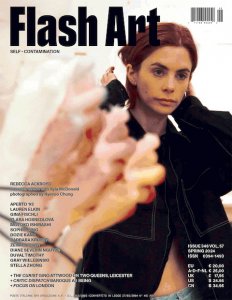

Covers: Klára Hosnedlová by Joseph Kadow / Duval Timothy by
Liz Johnson Artur / Diane Severin Nguyen by Richard Kern / Rebecca Ackroyd by Hyesoo Chung / Dozie Kanu by Renell Medrano; features: Klára Hosnedlová by Ella Plevin; Duval Timothy in conversation with Grace Wales Bonner; Diane Severin Nguyen by Olivia Kan-Sperling; Rebecca Ackroyd in conversation with Kyla McDonald; Dozie Kanu in conversation with Precious Okoyomon; Focus On London: Thoughts of Elsewhere by Amy Jones; Zeinab Saleh in conversation with Gea Politi; Gina Fischli by Margaret Kross; Barbara Kruger by Clem MacLeod; Baroque as Being by Rose Higham-Stainton; Gino Attwood in conversation with Caroline Elbaor; Gray Wielebinski in conversation with Philomena Epps; Motoko Ishibashi in conversation with Cassidy George;Stella Zhong by Alex Bennett; Sophie Jung by
Estelle Hoy; APERTO '93 by Helena Kontova, Jeffrey Deitch, and
Francesco Bonami; I want it to be, and I want it not to be by Lauren Elkin; reviews: "Going Dark: The Contemporary Figure at the Edge of Visibility" Solomon R. Guggenheim Museum, New York by Chiara Mannarino; Paul Pfeiffer "Prologue to the Story of the Birth of Freedom" MOCA – Museum of Contemporary Art, Los Angeles by Sampson Ohringer; Jasmine Gregory "Si je ne peux pas l'avoir, toi non plus" CAPC – Musée d'art Contemporain de Bordeaux by Sarah Moroz;
Dora Budor "Again" Nottingham Contemporary by Frank Wasser; Biennale de l'Image en Mouvement CAC – Centre d'Art Contemporain, Genève by Marilena Borriello; Meredith Monk "Calling" Haus der Kunst, Munich and Oude Kerk, Amsterdam by Philipp Hindahl; "Our Ecology: Toward a Planetary Living" Mori Art Museum, Tokyo by Maki Nishida.
This issue comes with four different covers, randomly distributed.
Flash Art is a contemporary art and culture magazine founded in 1967. Within a decade, it became an indispensable point of reference for artists, critics, collectors, galleries, and institutions. In 2020, Flash Art became a quarterly publication, at the same time increasing its trim size and updating its graphic identity. The magazine offers a fresh perspective on the visual arts, covering a range of transdisciplinary approaches and fostering in-depth analyses of artist practices and new cultural directions. Today, Flash Art remains required reading for all who navigate the international art scene.
Flash Art is known for it covers featuring artists who subsequently become leading figures in the art world. The magazine includes photoshoots, productions, critical essays, monographic profiles, conversations with emerging and established artists, and a range of ongoing and thematic columns that change every few years. The long history of the magazine is also highlighted by pivotal texts from the archive that are included in the publication time to time. Finally, every issue offers a highly curated selection of the best institutional exhibitions on the global scene.
